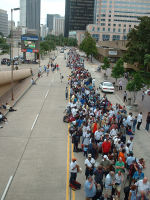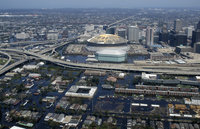Louisiana Superdome
From Wikipedia, the free encyclopedia.
| Louisiana Superdome | |
| The Superdome | |
| Facility statistics | |
|---|---|
| Location | 1500 Poydras Street New Orleans, Louisiana 70112 |
| Broke ground | August 11, 1971 |
| Opened | August 3, 1975 |
| Closed | September 2, 2005 (indefinitely) |
| Demolished | N/A |
| Owner | Louisiana Stadium/Expo District, Glenn Menard (Manager) |
| Operator | Spectacor Management Group |
| Surface | concrete based multi-purpose floor, AstroTurf non-football related events, and FieldTurf American Football playing surface |
| Construction cost | $134 million USD |
| Architect | Huber, Hunt & Nichols |
| Former names | |
| N/A | |
| Tenants | |
| New Orleans Saints (NFL) (1975–2005) Sugar Bowl (NCAA) (1975–2005) Tulane Green Wave (NCAA) (1975–2005) New Orleans Jazz (NBA) (1975–1979) New Orleans Breakers (USFL) (1984) |
|
| Seating capacity | |
| 72,003 Football 55,675 Basketball 63,525 Baseball |
|
The Louisiana Superdome, often informally referred to simply as the Superdome, is a large, multi-purpose sports and exhibition facility located in the Central Business District of New Orleans, Louisiana, USA (29.951° N 90.081° W). The Superdome is the current home of the NFL's New Orleans Saints and the former home of the New Orleans Jazz (now the Utah Jazz) NBA franchise.
The stadium was badly damaged from Hurricane Katrina's winds and flooding, and authorities said it contained a "probable biohazard" resulting from trash and human waste left in the building when it was used as a "shelter of last resort" for those who weren't able to flee the city. The facility has been closed indefinitely and will not be used during the 2005 football season.
Contents |
Stadium history
The Superdome can trace its origins back to 1967. Then governor of Louisiana, John J. McKeithen, attended a baseball game at the Astrodome in Houston, Texas. McKeithen was very impressed with the large domed stadium. During the game he was quoted as saying, "I want one of these, only bigger," in reference to the Astrodome itself. He would get his wish five years later.
Construction started on the Louisiana Superdome on August 11, 1971 and was finished in November 1975. The Girod Street Cemetery was demolished to make space for it; some superstitious locals attribute the poor record of the New Orleans Saints to bad luck produced by disturbing the tombs, although it should be noted that the Saints had a mediocre record since they began play in 1967 in New Orleans's older major sports arena, the venerable Tulane Stadium, which was condemned on the day the Superdome opened.
The New Orleans Saints opened the 1975–1976 NFL season at the Superdome.
The Superdome is a massive structure located on 52 acres (210,000 m²) of land; the dome has an interior space of 125,000,000 ft³ (3,500,000 m³), a height of 253 feet (82.3 meters), a dome diameter of 680 feet (210 meters), and a total floor area of 269,000 ft² (25,000 m²). It was the largest domed structure in the world until it was overtaken at the completion of the Georgia Dome in Atlanta, in 1992.
The Superdome has a listed maximum football seating capacity of 72,003 (expanded) or 69,703 (not expanded), a maximum basketball seating capacity of 55,675, and a maximum baseball capacity of 63,525; however, published attendance figures from events such as the Sugar Bowl have exceeded 79,000.
More Super Bowls have been played at the Louisiana Superdome than at any other sports facility: 1978, 1981, 1986, 1990, 1997, and 2002. The Superdome also hosts the Sugar Bowl, the New Orleans Bowl, Tulane University college football home games, and the Bayou Classic football game between two historically black universities, Grambling State and Southern University. The facility has also hosted several NCAA college basketball Final Fours: 1982, 1987, 1993, and 2003.
In addition to sporting events, the Superdome hosts other large events, notably music concerts by national acts, as well as trade shows and conventions. The 1988 Republican National Convention was held in the Superdome.
Overall, the Louisiana Superdome has withstood the test of time; it has a surprisingly undated look to it; fixed domed stadium construction began to fade in the early 1990s and some others have even been closed.
The New Orleans Arena, a smaller indoor arena adjacent to the Louisiana Superdome, opened on October 19, 1999.
Hurricane Katrina
- Main article: Effect of Hurricane Katrina on New Orleans

The Superdome was used as a "shelter of last resort" for those in New Orleans unable to evacuate from Hurricane Katrina when it struck in late August 2005. This was the third time the dome had been used as a shelter; it was previously used in 1998 during Hurricane Georges and in 2004 during Hurricane Ivan. During Georges, the Superdome had no problems related to the weather, but the evacuees stole furniture and damaged property that resulted in thousands of dollars in losses, and there were difficulties supplying the more than 14,000 people living temporarily in the dome with necessities. About a thousand special-needs patients were housed there when Ivan hit the area.
Approximately 9,000 residents and 550 National Guardsmen rode out the night in the Superdome as Katrina came ashore. Maj. Gen. Bennett C. Landreneau, Adjutant General for the Louisiana National Guard, said that the number of people taking shelter in the Superdome rose to around 15,000 to 20,000 as search and rescue teams bring more people to the Superdome from areas hit hard by the flooding. During Katrina, officials set up security checkpoints, and confiscated alcohol, weapons, and illicit drugs from those seeking refuge in the building. [1]
The Superdome was built to withstand most catastrophes; the roof was ostensibly estimated to be able to withstand winds with speeds of up to 200 mph, but flood waters could still possibly reach the second level 20 feet from the ground, making the structure an unreliable shelter in severe rain and wind. However, when looking into the origins of this 200 mph wind security in the Superdome, CNN reported that no engineering study has ever been completed on the amount of wind the structure can withstand; the building's engineering study was underway as Hurricane Katrina approached and was put on hold. It was used as an emergency shelter although it was not designed nor tested for the task.
On August 29, 2005, at about 9:00 AM EDT, reports from inside the Superdome were that part of the roof was "peeling off," daylight could be seen from inside the dome, and rain was pouring in. The Associated Press stated there were two holes, "each about 15 to 20 feet long and 4 to 5 feet wide." and that water was making its way in at elevator shafts and other small openings. [2]
That same morning of August 29, during an interview on ABC news, Governor Kathleen Blanco called the Superdome shelter strategy an "experiment," when asked if it could hold the storm or the flood.

Despite the planned use of the Superdome as an evacuation center, government officials at the local, state and federal level came under criticism for poor planning and preparation. On August 28 the Louisiana National Guard delivered three truckloads of water and seven truckloads of MREs (meals ready to eat), enough to supply 15,000 people for three days. There was no water purification equipment on site, no chemical toilets, no anti-biotics and no anti-diarrheals stored for a crisis. There were no designated medical staff at work in the evacuation center. There was no established sick bay within the Superdome, and there were very few cots available that hadn't been brought in by evacuees. The mayor of New Orleans had, in fact, stated that as a "refuge of last resort," only limited food, water, and supplies would be provided. Residents who evacuated to the Superdome were warned to bring their own supplies.
When the flooding began on August 30, the Superdome began to slowly fill with water, though it remained confined to the field level. Later that day, Governor Blanco ordered New Orleans completely evacuated. [3] On August 31, it was announced that the Superdome refugees would move to the Reliant Astrodome in Houston, Texas. With no power and no water, sanitary conditions with the Superdome had rapidly deteriorated. [4] [5][6] As of August 31, there had been three deaths in the Superdome: two elderly medical patients and a man who is believed to have committed suicide by jumping from the upper level seats. There were also unconfirmed reports of rape, vandalism, violent assaults, crack dealing/drug abuse, and gang activity inside the Superdome. On September 11, New Orleans Police Superintendent Eddie Compass reported there were "no confirmed reports of any type of sexual assault."[7].
National Guardsmen accompanied by buses (475 in all) and supply trucks arrived at the Superdome on September 1. The buses were sent to pick up the evacuees from the Superdome and, later, the New Orleans Convention Center, where more than 20,000 people had been crowded in similarly poor living conditions. 13,000 evacuees were taken to the Reliant Astrodome in Houston. By September 4, the last large group of refugees in the Superdome had been evacuated.
With the roof damaged by water and wind, water and electricity spotty at best, damage to the overall interior and exterior structures, and a "potential biohazard" from human waste and trash, the Superdome's fate is uncertain. After initial reports that the building's damage was so severe that it would have to be torn down, state officials now say it will be unusable for at least a year. State officials estimate damages at around $400 million. Doug Thornton, a regional vice president for Spectacor Management Group, who operates the stadium for the state, told the Times-Picayune that it will take two to three weeks to decontaminate it, and another 45 days to determine whether it is structurally sound. However, state officials say repairs to the Superdome are far down the list of priorities. [8]
Team activities after Katrina
The New Orleans Saints will play four of their scheduled home games at LSU's Tiger Stadium in Baton Rouge and three at the Alamodome in San Antonio. [9]. Tulane has postponed its scheduled game against the University of Southern Mississippi to November 26. Their first game, against Mississippi State University, was played September 17 at the Independence Bowl in Shreveport, Louisiana. The venues for their remaining home games has not been determined.
On October 21, 2005 Benson issued a statement saying that he has not made any decision about the future of the Saints. [10]. However, the San Antonio Express-News reported that sources close to the Saints' organization say that Benson does plan to void his lease agreement with New Orleans by declaring the Superdome unusable. [11]









